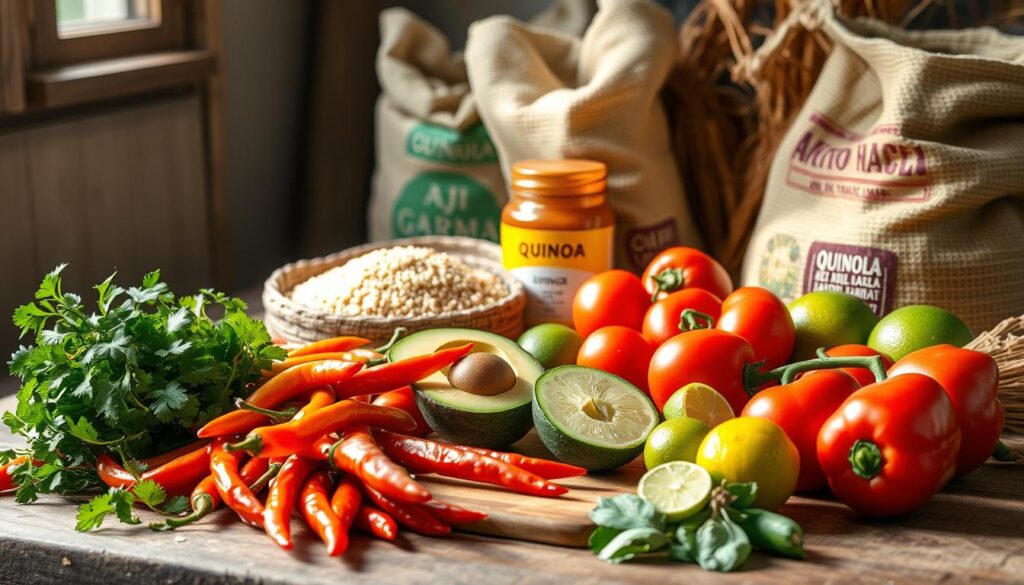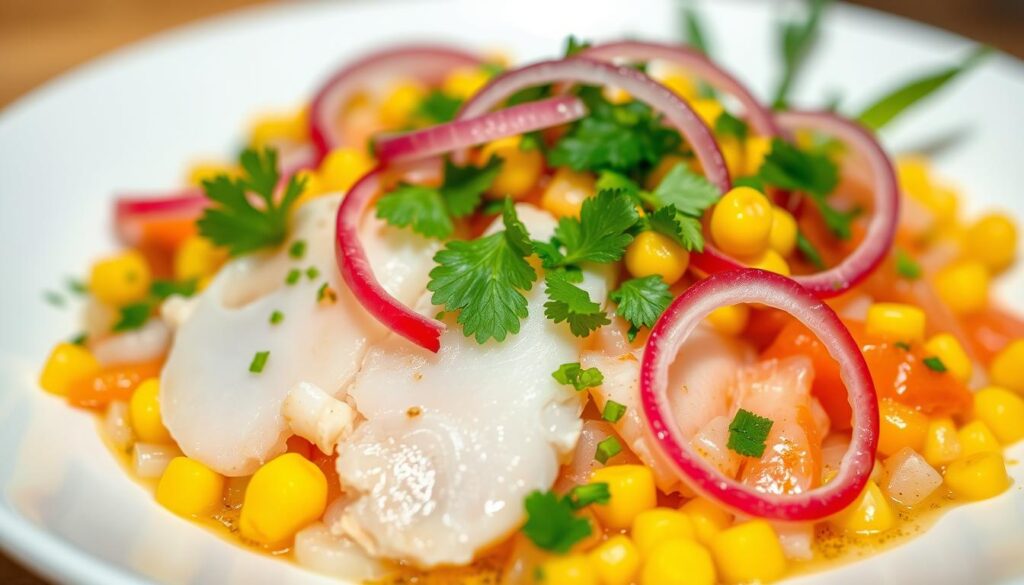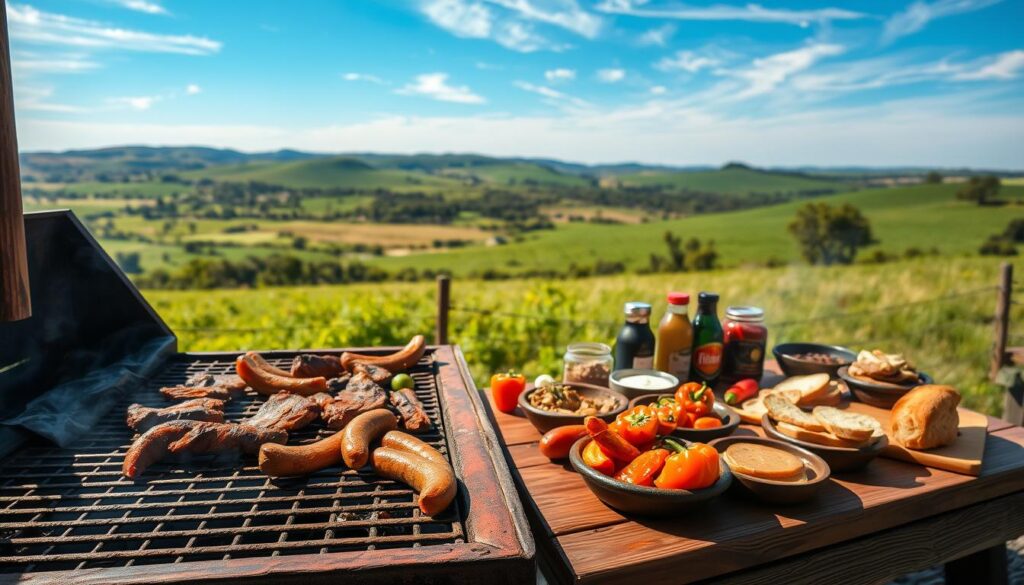The smell of sizzling meat fills the air, taking you to sunny plazas and lively markets. Your taste buds start to tingle as you start a food journey through South America. From Peru’s coastal treats to Argentina’s hearty dishes, the food here is a feast for your senses.
Exploring South American food, you find a mix of flavors from old traditions and new influences. Every bite of these dishes shares a story of culture and diversity. Whether you love food or just want to try new things, these top 10 dishes will excite your taste and make you want to travel.
Prepare to enjoy the zesty ceviche from Peru, the smoky asado from Argentina, and the cozy feijoada from Brazil. These famous dishes are just the start of your food adventure in South America. So, pick up your fork and let’s explore the tasty treats waiting for you!
Key Takeaways
- South American cuisine blends indigenous and colonial influences
- The top 10 must-try dishes showcase regional diversity
- Popular dishes include ceviche, asado, and feijoada
- Each dish reflects unique cultural traditions
- Exploring South American foods offers a rich culinary experience
Understanding South American Cuisine’s Rich Heritage
South American cuisine has a deep history. It mixes indigenous traditions with colonial influences. This mix creates a unique taste experience. Let’s look at how traditional South American food has shaped modern Latin American cuisine.
Indigenous Influences on Modern Dishes
The native peoples of South America have greatly influenced its food. Ingredients like quinoa, potatoes, and corn are still used today. These foods are the base of many dishes, showing the lasting impact of pre-Columbian cooking.

Colonial Impact on South American Cooking
European colonization introduced new ingredients and cooking methods. This mix created many famous dishes in Latin American cuisine. For example, Spanish colonizers brought beef, leading to Argentina’s asado tradition.
Regional Diversity in Cooking Methods
South America’s different landscapes have led to varied cooking methods. From the Andean highlands to the Amazon rainforest, each area has its own way of cooking. This diversity is part of the rich culinary heritage across the continent.
| Region | Signature Dish | Key Ingredient | Cooking Method |
|---|---|---|---|
| Andes | Cuy | Guinea Pig | Roasting |
| Amazon | Tacacá | Jambu Leaves | Boiling |
| Pampas | Asado | Beef | Grilling |
| Coast | Ceviche | Fish | Curing |
Peruvian Ceviche: The Coastal Delicacy

Peruvian ceviche is a top pick among South American seafood dishes. It comes from Peru’s coast, where seafood is plentiful. In Lima, you’ll see ceviche everywhere, from street food to fancy restaurants.
The secret of ceviche is its bold flavors. Raw fish or seafood is marinated in lime juice. This makes the dish tender and flavorful. Chefs add red onions, cilantro, and aji peppers for more taste.
Expect to pay $18 to $21 for ceviche at restaurants. Here’s what you might find:
| Type of Ceviche | Price | Description |
|---|---|---|
| Classic Ceviche | $18.50 | Catch of the day with traditional rocoto tiger’s milk |
| Mixed Ceviche | $21.00 | Assortment of seafood in citrus marinade |
But ceviche is more than just fish. It’s served with choclo (Peruvian corn), cancha (toasted corn), and sweet potatoes. These add balance and texture.
To truly experience ceviche, visit Peru’s coastal areas. Fresh seafood makes the best ceviche!
Argentine Asado: The Art of South American Grilling
Argentine asado is more than a meal; it’s a cherished social ritual in Argentina and Uruguay. It brings people together, celebrating food and friendship. As you explore South American cuisine, you’ll find asado at the heart of many gatherings.

Traditional Grilling Techniques
In Argentina, grilling is an art form. The asador (grill master) carefully tends to the fire, using wood or charcoal to create the perfect heat. The grill, or parrilla, is often a simple iron grate over hot coals. This slow-cooking method infuses the meat with a smoky flavor that’s hard to resist.
Essential Cuts of Meat
No asado is complete without a variety of meats. You’ll typically find:
- Chorizo: Spicy sausages that start the meal
- Costillas: Succulent beef ribs
- Vacio: Flank steak, a local favorite
- Lomo: Tender beef tenderloin
Accompaniments and Sauces
While the meat takes center stage, the sides are equally important. Chimichurri sauce, a blend of herbs, garlic, and oil, is a must-have. You’ll also find crisp salads and grilled vegetables to balance the rich meats. In Argentina and Uruguay, asado isn’t just food – it’s a way of life that brings people together over the grill.
Brazilian Feijoada: A National Treasure
Feijoada is a key part of Brazilian food, loved by South Americans. It’s Brazil’s national dish, enjoyed by 90% of the people. It’s often shared on Wednesdays and Saturdays, bringing families and friends together.
Making feijoada is a big job, taking up to 12 hours. The slow cooking mixes the flavors of meats like pork and beef with black beans. This makes a delicious, filling meal, with about 700-800 calories per serving.
In big cities like São Paulo, feijoada is on 30% of menus. For a real taste of Brazil, try Casa da Feijoada. It’s a place all about feijoada. Served with rice, collard greens, and orange slices, it’s a full meal that shows Brazilian hospitality.
| Feijoada Facts | Statistics |
|---|---|
| Brazilian Consumption Rate | 90% |
| Social Dining Percentage | 60% |
| Preparation Time | 12 hours |
| Average Calories per Serving | 700-800 |
| Popularity Among Tourists | 45% |
South American Foods: Regional Variations and Traditions
South American cuisine is a mix of flavors from different lands and cultures. From the Andes to the Amazon and the coast, each area has its own food traditions. These traditions make South American food so special.
Andean Cuisine Characteristics
The Andean region is famous for its warm, hearty dishes. Potatoes, quinoa, and corn are common here. In Peru, cuy (guinea pig) is a prized dish.
Bolivia’s salteñas, savory pastries, are a favorite street food. They’re filled with meat and veggies.
Amazonian Ingredients
The Amazon rainforest is home to unique ingredients. Fruits like açaí and cupuaçu are packed with nutrients. Fish like pirarucu are also common in dishes.
In Brazil, tacacá is a soup made with jambu leaves and tucupi sauce. It’s a taste of the Amazon.
Coastal Culinary Influences
Coastal areas focus on seafood, similar to Mediterranean cuisine. In Chile, chupe de mariscos (seafood stew) is loved. Ecuador’s encebollado, a fish soup, is a national treasure.
Studies on food enzymes show how traditional cooking boosts nutrition in these dishes.
| Region | Key Ingredients | Popular Dish |
|---|---|---|
| Andean | Potatoes, Quinoa, Corn | Cuy (Guinea Pig) |
| Amazonian | Açaí, Pirarucu, Jambu | Tacacá |
| Coastal | Seafood, Fish, Coconut | Chupe de Mariscos |
Colombian Arepas: Versatile Street Food
Arepas are a favorite street food in Colombia, giving a taste of Latin American cuisine. These corn-based treats have been around since ancient times. They were first made when corn was first grown in Mexico. Now, you can smell arepas cooking on grills all over Colombia.
Making arepas has changed over time. What used to take a lot of work now takes about 30 minutes. Cooks shape the dough into flat, round discs. They cook them by frying, grilling, or roasting. This makes a crispy outside and a soft, warm inside, ready for fillings.
There are many ways to fill arepas. You can put cheese, meat, or beans inside for a savory treat. Or, you can try a sweet version with molasses. A favorite is a stuffed egg, a protein-packed breakfast on the go. As you explore Colombia’s culinary scene, you’ll find many unique arepa flavors.
Street food is a big part of Colombian culture, and arepas are a top pick. People often buy these portable meals at home. If you visit Colombia, trying an authentic arepa is a must for food lovers.
Chilean Empanadas: Savory Pastry Perfection
Chilean empanadas are a standout in South American dishes. They have a flaky crust and tasty fillings. In Chile, they’re more than food; they’re a cultural symbol.
Traditional Fillings
The favorite filling is “de pino,” with ground beef, onions, raisins, and olives. Empanadas de gallina, filled with chicken, are also loved. Vegetarian choices include cheese and spinach.
Each empanada has about 210 calories and 7 grams of protein. They’re great as a snack or meal.
Baking Methods
Chilean empanadas are baked, not fried. The best oven temperature is 200°C (400°F). This makes the outside crispy and the inside moist.
Baking takes 20-25 minutes, filling your kitchen with a wonderful smell. To get a flaky crust, brush the top with egg wash before baking.
“Empanadas are Chile’s comfort food. They remind us of family gatherings and holidays,” says Maria, a local chef in Santiago.
Exploring Chile or making empanadas at home? They offer a delicious taste of South American cuisine. Their portability and variety of fillings make them perfect for any time.
Uruguayan Chivito: The Ultimate Steak Sandwich
The chivito is Uruguay’s top dish, a sandwich that’s full of flavor. It has a juicy steak, a fried egg, ham, cheese, and fresh veggies. It’s as good as the famous steaks from Buenos Aires.
This sandwich was born in Punta del Este and now everyone loves it. You can find it everywhere, from big cities to small towns. It’s a mix of textures and tastes that food lovers can’t miss.
To try a real chivito, go to local restaurants in Uruguay. Lunch, including a chivito, costs about $10 in Montevideo. Add a local beer for $3, and you have a great meal that’s affordable.
If you can’t go to Uruguay, you can make this sandwich at home. Use a tender steak, crispy bacon, a fried egg, and fresh lettuce and tomato. Put it all on a soft bun, and you’ll taste Uruguay in your kitchen.
| Ingredient | Quantity |
|---|---|
| Steak | 1 thin slice |
| Fried egg | 1 |
| Ham | 2 slices |
| Cheese | 1 slice |
| Lettuce | 1 leaf |
| Tomato | 2 slices |
The chivito shows Uruguay’s love for food and welcoming nature. It’s more than a sandwich; it’s a cultural experience. Next time you want a big meal, try the Uruguayan chivito!
Ecuadorian Locro de Papa: Potato Soup Delicacy
Discover the heartwarming comfort of Ecuadorian locro de papa. It’s a beloved potato stew that captures the essence of Andean cuisine. This creamy, satisfying dish showcases Ecuador’s rich culinary heritage and the country’s love affair with potatoes.
Key Ingredients
Locro de papa combines simple yet flavorful ingredients to create a truly memorable meal. The star of the show is, of course, potatoes. Ecuador boasts over 4,000 varieties of potatoes, making it the perfect base for this hearty stew. Other key components include:
- Cheese (typically queso fresco)
- Milk or cream
- Onions and garlic
- Avocado
- Corn (choclo)
Regional Variations
While the basic recipe remains consistent throughout Ecuador, you’ll find delightful regional twists. In coastal areas, chefs might incorporate cassava or sweet potato for added depth. Mountain regions often include more hearty vegetables like carrots or celery. Some variations even feature meat, transforming the stew into a more substantial meal.
| Region | Unique Addition | Flavor Profile |
|---|---|---|
| Coastal | Cassava or sweet potato | Slightly sweet, creamy |
| Andean | Quinoa or fava beans | Earthy, protein-rich |
| Amazonian | Plantains or yuca | Tropical, hearty |
Whether you’re exploring the bustling streets of Quito or the serene Andean highlands, locro de papa offers a taste of authentic Ecuadorian cuisine. This comforting stew warms both body and soul, making it a must-try dish for any food lover visiting South America.
Venezuelan Pabellón Criollo: A Complete Meal
Discover the heart of Venezuelan cuisine with Pabellón Criollo. It’s more than a dish; it’s a cultural icon. This complete meal combines shredded beef, black beans, rice, and fried plantains. It offers a perfect balance of flavors and textures.
At $23.00, it’s a must-try dish for food enthusiasts exploring South American culinary. It’s a must-try for anyone who loves food.
The history of Pabellón Criollo reflects Venezuela’s diverse cultural influences. Each component represents a different aspect of the country’s heritage. The beef symbolizes the Spanish colonizers, the beans represent the indigenous people, the rice nods to the African influence, and the plantains showcase the tropical bounty.
When you savor this dish, you’re tasting centuries of Venezuelan history. It’s a taste of the country’s rich heritage.
To fully enjoy Pabellón Criollo, pair it with other Venezuelan specialties. Try tequenos (cheese sticks) at $13.00 for 5 pieces, or mini empanadas at $16.50 for 4 pieces. For a lighter option, the goat cheese salad at $11.00 complements the hearty main dish perfectly.
Remember, many restaurants offer free delivery for orders over $30. This makes it easy to explore this rich culinary tradition from the comfort of your home.

